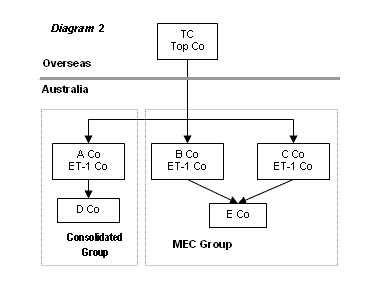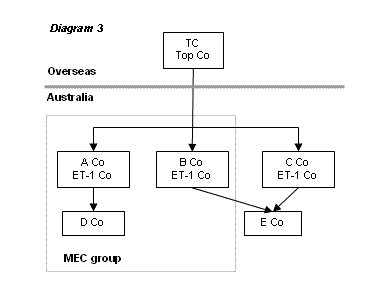Taxation Determination
TD 2005/38
Income tax: consolidation: membership: are the eligible tier-1 companies of a foreign-owned group required to form a single MEC group which includes all those eligible tier-1 companies?
-
Please note that the PDF version is the authorised version of this ruling.
FOI status:
may be releasedPreamble
| The number, subject heading, date of effect and paragraph 1 of this document are a 'public ruling' for the purposes of Part IVAAA of the Taxation Administration Act 1953 and are legally binding on the Commissioner. |
1. No, it is not necessary for all eligible tier-1 companies of a foreign-owned group to form a single MEC (multiple entry consolidated) group.
2. A MEC group is formed when two or more eligible tier-1 companies of a foreign company (the top company) make a choice to consolidate; a potential MEC group derived from those companies (section 719-50 and paragraph 719-5(1)(a) of the Income Tax Assessment Act 1997 (ITAA 1997)). The choice to consolidate the potential MEC group derived from those particular eligible tier-1 companies cannot be revoked (subsection 719-50(2) of the ITAA 1997). A MEC group can also be formed as a result of a special conversion event happening to a consolidated group (section 719-5 and section 719-40 of the ITAA 1997).
3. For any foreign-owned group that has more than one eligible tier-1 company, several potential MEC groups may be identified (section 719-10 of the ITAA 1997). For example, if the group contains two eligible tier-1 companies, three potential MEC groups may be identified:
- •
- a potential MEC group consisting of the first eligible tier-1 company and its wholly-owned Australian subsidiaries, if any, meeting the condition in paragraph 719-10(1)(b) and (where applicable) subsection 719-10(2) of the ITAA 1997 (described for convenience in this Taxation Determination simply as 'wholly-owed Australian subsidiaries');
- •
- a potential MEC group consisting of the second eligible tier-1 company and its wholly-owned Australian subsidiaries, if any; and
- •
- a potential MEC group consisting of the two eligible tier-1 companies together and their wholly-owned Australian subsidiaries, if any.
Similarly, seven potential MEC groups may be identified in relation to a foreign-owned group that has three eligible tier-1 companies.
4. The provisions in the law governing the formation of consolidated and MEC groups allow a foreign-owned group flexibility to form one or more MEC groups, a series of consolidated groups, or a combination of consolidated and MEC groups (where the group structure permits). The provisions also allow individual eligible tier-1 companies to remain outside any consolidated or MEC group.
5. Each of the potential MEC groups which can be identified within a foreign-owned group may individually consider the possibility of forming a consolidated group under section 703-50 of the ITAA 1997, or a MEC group under section 719-50 of the ITAA 1997, as appropriate. For example, a single eligible tier-1 company of the top company, if it has one or more wholly-owned Australian subsidiaries, may choose under section 703-50 of the ITAA 1997 to form a consolidated group from the potential MEC group consisting of itself and those subsidiaries. Alternatively, the eligible tier-1 company may join one or more other eligible tier-1 companies (but not necessarily all the eligible tier-1 companies of the top company) to form a MEC group under section 719-50 of the ITAA 1997. The MEC group would comprise the members of the potential MEC group made up of the eligible tier-1 company, the other eligible tier-1 companies, and each of their wholly-owned Australian subsidiaries. A single eligible tier-1 company without any wholly-owned subsidiaries cannot, however, form a consolidated group on its own.
Example 1
6. X Co and Y Co are eligible tier-1 companies of TC, the top company of a foreign-owned group. Neither X Co nor Y Co have any subsidiaries. While three potential MEC groups may be identified within this group structure, neither X Co nor Y Co may form a consolidated group in its own right. The only choice available to the corporate group under Part 3-90 of the ITAA 1997 as to consolidation is to form a MEC group consisting of X Co and Y Co.
Example 2
7. M Co and N Co are eligible tier-1 companies of TC, the top company of a foreign-owned group. O Co is a wholly-owned subsidiary of N Co. M Co has no subsidiaries. As in Example 1, three potential MEC groups may be identified within this group structure. However, only two choices are available to the corporate group under Part 3-90 of the ITAA 1997 as to consolidation. First, N Co may choose to form a consolidated group with O Co as a subsidiary member. In this scenario, M Co will remain outside the consolidated group. Alternatively, the group consisting of M Co, N Co and O Co may together form a MEC group. M Co is not able to form a consolidated group in its own right.
Example 3
8. A Co, B Co and C Co are eligible tier-1 companies of TC, the top company of a foreign-owned group. ACo owns all of the membership interests in D Co. B Co and C Co jointly own all the membership interests in E Co.
Diagram 1 - If A Co, B Co and C Co make a choice to form a MEC group under section 719-50 of the ITAA 1997, D Co and E Co automatically join the MEC group as subsidiary members.

Diagram 2 - Alternatively, ACo can form a consolidated group with D Co. B CO and C Co can form a MEC group with subsidiary member E Co.

Diagram 3 - Alternatively, A Co and B Co can choose to form a MEC group with subsidiary member D Co. In this scenario, E Co would be unable to join this MEC group as it is not wholly owned by the eligible tier-1 companies that chose to form the MEC group. Further, C Co is unable to choose to form a consolidated group because it does not have a wholly-owned subsidiary. Note: C Co is not able at some future date to choose to become part of the MEC group consisting of A Co, B Co and D Co as an eligible tier-1 company (refer section 719-5 of the ITAA 1997).

Date of effect
9. This Determination applies to years commencing both before and after its date of issue. However, it does not apply to taxpayers to the extent that it conflicts with the terms of settlement of a dispute agreed to before the date of the Determination (see paragraphs 21 and 22 of Taxation Ruling TR 92/20).
Commissioner of Taxation
19 October 2005
Previously issued as TD 2005/D6
References
ATO references:
NO 2004/12062
Related Rulings/Determinations:
TR 92/20
Subject References:
choice to form
consolidated group
consolidation
consolidation - formation
consolidation - membership
consolidation - multiple entry consolidated groups
eligible tier-1 company
foreign-owned group
potential MEC group
special conversion event
top company
Legislative References:
TAA 1953 Pt IVAAA
ITAA 1997 Pt 3-90
ITAA 1997 703-50
ITAA 1997 719-5
ITAA 1997 719-5(1)(a)
ITAA 1997 719-10
ITAA 1997 719-10(1)(b)
ITAA 1997 719-10(2)
ITAA 1997 719-40
ITAA 1997 719-50
ITAA 1997 719-50(2)
Copyright notice
© Australian Taxation Office for the Commonwealth of Australia
You are free to copy, adapt, modify, transmit and distribute material on this website as you wish (but not in any way that suggests the ATO or the Commonwealth endorses you or any of your services or products).
